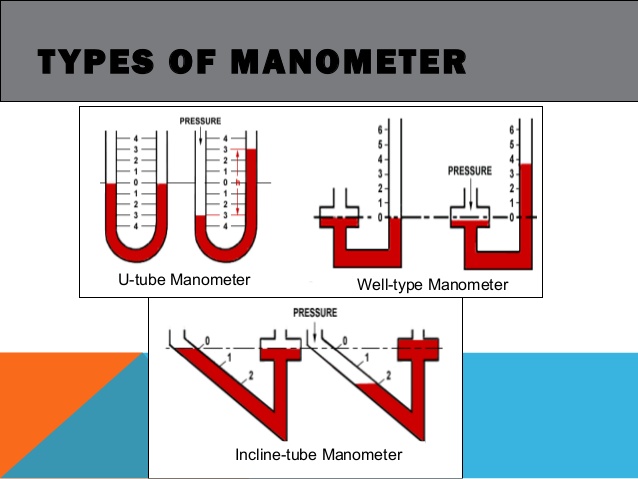Manometer Type
Definition :
1) U-Tube Manometer:
This manometer is very simple to construct. It consists of a U – shaped bent tube whose one end is attached to the gauge point ‘A’ and other end is open to the atmosphere. It is then filled with a fluid. The density of the fluid dictates the range of pressures that can be measured.
If one port is left open to the atmosphere and the other port is connected to the pressure to be measured, the device acts as a gauge pressure meter. If both ports are connected to two different unknown pressures, the instrument acts as a differential pressure gauge.
It can measure both positive and negative pressures. It contains liquid of specific gravity greater than that of a liquid of which the pressure is to be measured.
where ‘γ’ is Specific weight of the fluid, ‘P’ is Pressure at A (which u r going to calculate).
Hence; Pressure at A is P = γ2h2 – γ1h1
2) Differential U-Tube Manometer:
Differential U-tube manometer is very similar to the U-tube manometer as we discussed above. Here one open end (which was considered as atmospheric end in U-Tube manometer ) is connected to another pressure point i.e
This manometer is basically used to measure the differences between to different points or you can say we ae going to calculate the difference
Pressure difference between A and B is given by equation
After rearranging
3) Inverted U-Tube Manometer:
Inverted U-Tube manometer is used for the measurement of small pressure differences in liquids. It consists of an inverted U – Tube containing a light liquid. This is used to measure the differences of low pressures between two points where better accuracy is required. It generally consists of an air cock at top of manometric fluid type.
Note : Inverted U-tube differential manometer will be used for measuring the vacuum pressure. Inverted U-tube differential manometer will have one inverted U-tube contained with light liquid.
Let us consider that inverted U tube differential manometer is connected with two points in two pipes as displayed here in following figure. These two pipes are filled with different specific gravity liquid. As displayed here in figure, point A and point B are at different level.
Pressure difference can be calculated from the below mentioned equation
PA – ρ1gH1 – ρmg(H2– H1) = PB – ρ2gH2
PA – ρ1g H1 = PB – ρ2g H2 – ρL g H
After rearranging
PA – PB = ρ1g H1 – ρ2g H2 + ρmg(H2– H1)
Where ρm = density of manometric fluid
ρ2 , ρ1 = desity of two different fluids
4) Micro Manometer:
The micromanometer is a special type of of liquid column manometers that which is based on the principle of inclined tube manometer. It used for the measurement of extremely small differences of pressure or very low pressure differences. One can say micro-manometer is the modified form of a simple manometer whose one limb is made of larger cross sectional area. It measures very small pressure differences with high precision.
Let ‘a’ = area of the tube,
A = area of the reservoir,
h3 = Falling liquid level reservoir,
h2 = Rise of the liquid in the tube,
By conversation of mass we get A*h3 = a*h2
Equating pressure heads at datum we get
P1 = (ρm – ρ1)*gh3 + ρm*gh2 – ρ1*gh1
5) Inclined Manometer:
Inclined manometer is used for the measurement of small pressures and is to measure more accurately than the vertical tube type manometer. Due to inclination the distance moved by the fluid in manometer is more. An inclined manometer is a slightly curved tube with a liquid inside, typically a form of oil mixture. Along the tube’s middle portion are graduations. The graduations are commonly hundredths of an inch, depending on the manometer’s manufacturer.
Benifits :
The manometer’s inclined angle provides many advantages. A small or low amount of pressure against the inclined manometer will produce a large liquid movement relative to the tube’s graduations. As a result, the graduation scale can be very precise–down to a hundredth of an inch accuracy.
Pressure difference between A and B is give by equation.
Read Also : Venturi Flow Meter
Pitot Tube Working Principle
Coriolis Mass Flow Meter
References : NPTEL SCIENCING

